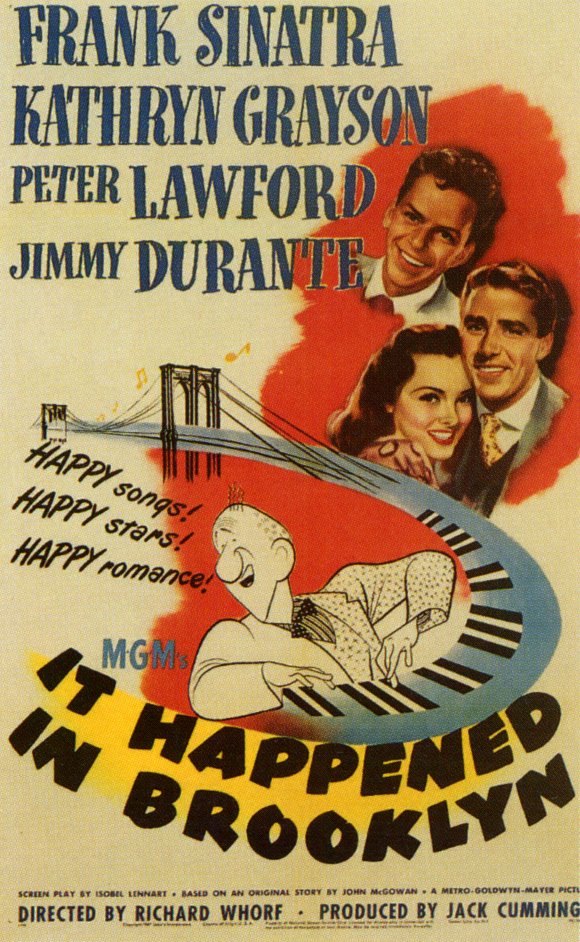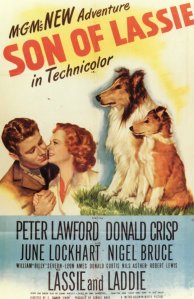 On an Island With You was director Richard Thorpe’s fourth film to star the shimmering sea creature Esther Williams.
On an Island With You was director Richard Thorpe’s fourth film to star the shimmering sea creature Esther Williams.
I didn’t get a chance to see the last film they made together, This Time for Keeps (1947), but I enjoyed On an Island With You a lot more than their second collaboration, the disappointing bullfighting drama Fiesta (1947), mostly because On an Island With You allows Williams to do what she did best — look stunning in and out of the water, and perform some spectacular water ballet numbers. (I’ve also never seen Thorpe’s first film starring Williams, Thrill of a Romance (1945) … what kind of an Esther Williams fan am I?!?)
In On an Island With You, she’s again paired with Mexican heartthrob Ricardo Montalban — her co-star in Fiesta (1947) — and also with Peter Lawford, who comes off as a real drip compared to the dashing Montalban.
This is too bad, since the audience is supposed to be rooting for Lt. Lawrence Y. Kingslee (Lawford), who fell in love with movie star Rosalind Rennolds (Williams) when he was serving in the South Pacific in World War II. Rosalind was doing a USO tour to raise the boys’ morale, and doesn’t even remember meeting Lt. Kingslee. She had too many brief romantic dalliances during the war to remember one more than any of the others, but for him it was the single most important event of his life.
As is all too common in movies from the ’40s, his romantic brio is so excessive it borders on stalking. During a break in the filming of Rosalind’s latest picture, Lt. Kingslee flies her away to the island where they met against her will. The rub is that real islands aren’t like islands in the movies. There are leeches and sinkholes, and when they’re away from the plane the natives steal the wheels. On the plus side, he remembers where he buried all the cans of Spam around the old Quonset hut where he used to bunk.
There’s a metafictional element to On an Island With You, since the film Rosalind is making with her fiancé, Ricardo Montez (played by Ricardo Montalban), is also called “On an Island With You,” and in all the spectacular dance numbers there are at least a few shots of the cameramen filming the action to remind you that they’re making a movie.
While I thought Lawford was miscast, there’s plenty of entertainment to be had in On an Island With You. Besides Williams’s luminescent screen presence and big water ballet numbers, Ricardo Montalban has some wonderful dances with Cyd Charisse — all high points of the film — and Xavier Cugat and his Orchestra are on hand for some good musical numbers. I especially liked Cugat’s tiny chihuahua.
Jimmy Durante has a big role in On an Island With You, too. He might even have more screen time than Lawford. I like Durante, but he’s not exactly the first person I want to see when I sit down to watch a Technicolor musical that takes place in the South Pacific.




 Son of Lassie could just as easily have been called Laddie Goes to War! In this follow-up to Lassie Come Home (1943), which starred Roddy McDowall and Elizabeth Taylor, Lassie has a son, named Laddie. Laddie grows ups, as does young Joe Carraclough, who was played by McDowall in the first film, but is here replaced by future Rat Pack member and Kennedy spouse Peter Lawford, whose slightly deformed arm kept him out of World War II. Joe joins the army, and Laddie tries to join up with him, but he cringes the first time blank cartridges are fired at his face, which disqualifies him as a canine soldier. When Joe is taken prisoner of war in Norway, however, Laddie … well, I don’t want to give anything away. (But if you’ve ever seen a “boy and his dog” movie before, you can probably predict what will happen.)
Son of Lassie could just as easily have been called Laddie Goes to War! In this follow-up to Lassie Come Home (1943), which starred Roddy McDowall and Elizabeth Taylor, Lassie has a son, named Laddie. Laddie grows ups, as does young Joe Carraclough, who was played by McDowall in the first film, but is here replaced by future Rat Pack member and Kennedy spouse Peter Lawford, whose slightly deformed arm kept him out of World War II. Joe joins the army, and Laddie tries to join up with him, but he cringes the first time blank cartridges are fired at his face, which disqualifies him as a canine soldier. When Joe is taken prisoner of war in Norway, however, Laddie … well, I don’t want to give anything away. (But if you’ve ever seen a “boy and his dog” movie before, you can probably predict what will happen.)